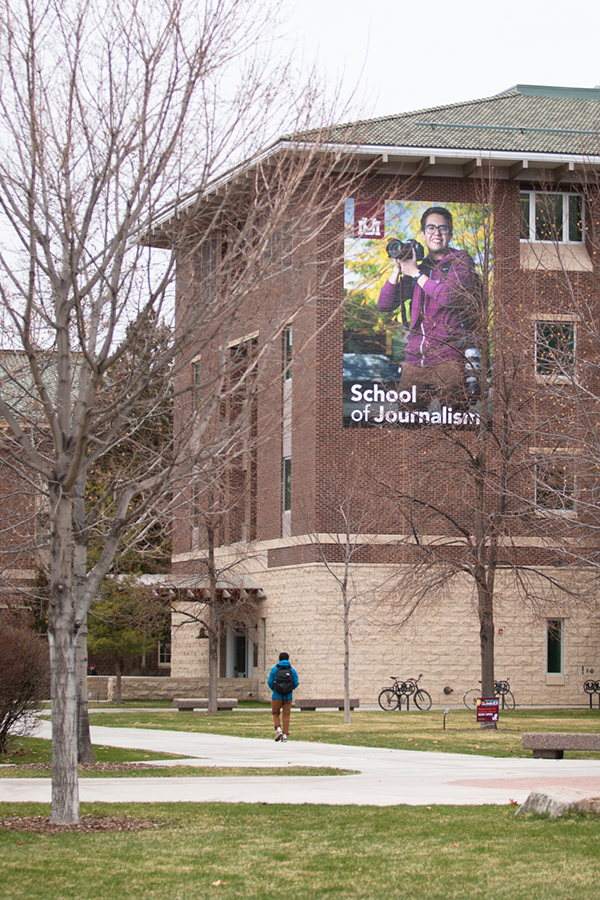Graduation Spotlight: Journalism Graduates Bring Modern Face to Media
MISSOULA – One student aspires to be a nightly news anchor. The other to serve as a photo editor for a major international publication.
Both have made a lasting mark on the University of Montana School of Journalism, and each believes their chosen profession is critical to a thriving democracy.
As they head to graduation this month, it’s no small wonder then that Austin Amestoy (the future anchor) and Antonio Ibarra (the future photo editor) exude an excitement born of the knowledge that they are ready take what they have learned at UM and make a difference in the world.
Amestoy, a native of Laurel, studied a broad swath of journalism subjects at UM but found covering the 67th Montana Legislature in 2021 as a statewide student reporter to be a formative experience.
“I love government reporting, and being in Helena was an incredible opportunity and a real launchpad for me,” said Amestoy, who minored in political science and spent the past three summers working as a TV reporter for KTVQ in Billings.
Learning about the inner workings of government came with an opportunity to try his hand at audio reporting, which led him to suggest that the student staffers of UM’s student newspaper, the Montana Kaimin, launch a podcast, where Amestoy serves as host.
An edition of that podcast – The Kaimin Cast – was a top 10 national finalist in the NPR College Podcast Challenge for 2022. It was one of multiple recognitions Amestoy has earned during the course of his collegiate career. Most recently, he was nominated for several student awards from the National Academy of Television Arts and Sciences-Northwest Region, which will be given out at the Emmy Awards ceremony in June.
“Austin came to UM to learn everything, and then he mastered all of it: writing, podcasting, videography, racking up awards and accolades in those areas and more,” said Jule Banville, associate professor in journalism and faculty adviser to the Kaimin “We know that he could go anywhere in the world of journalism and be a success, but if you've ever had even one conversation with Austin, you know Montana runs through his core. I can’t wait to see what he'll do.”
Ibarra moved to Montana from Morelos, Mexico as a child when his parents got jobs at the Rocky Mountain Laboratories in Hamilton and lived for a time in Tampa. His interest in writing started at an early age, he said, but his true love is photojournalism. He has made a name for himself in both fields, winning multiple awards and finalist rankings from Society of Professional Journalists and the William Randolph Hearst Journalism Awards Program, also known as the college Pulitzer Prizes.

“A lot of people asked me why I wanted to go into journalism, and I’ve said it’s to tell stories and highlight people you don’t always see in the media,” said Ibarra. “You have to have respect for your audience and learn from them.”
In addition to being known for his writing and photography, Ibarra gained campus notoriety as one of several students featured in large billboards on college buildings. He calls being the face of the journalism program a “humbling experience” and said plenty of undergraduate students deserved recognition.
“In the Kaimin office, Antonio is ‘Big Toni,’ and it’s not just because of the huge photo of him holding a camera on the side of the J-school,” said Banville. “Everything good about people is larger when it comes to Antonio – he’s the most generous, the most thoughtful, the one who's always positive. He has so much talent, and it’s great to see someone like him enter this profession and be an ambassador for kindness in the news biz.”
Denise Dowling, director of the School of Journalism, said Amestoy and Ibarra exemplify the world of modern journalism.
“They’ve successfully embraced the multifaceted platforms of today’s news – writing, photos, video, audio,” Dowling said. “And they’ve shown an understanding of which medium is most appropriate for the story they are telling.”
The support they give each other – in an interview they joke about being public relations representatives for the other – typifies the journalism program, Dowling added.
“The commitment to the profession and to fellow students really sets our school apart and makes it an inspiring place to be,” she said.
Following graduation, Amestoy will work as an intern for Montana Public Radio, producing the weekday newscasts. He hopes to do some reporting on the side.
Ibarra has been hired by Lee Enterprises, owners of the Missoulian and papers in Helena, Butte and Billings, as a statewide photographer and also looks forward to writing.
They credit their professors for helping them make initial and important connections to journalism outlets in the state, “and we expect their guidance won’t end at graduation,” Ibarra said.
Adds Amestoy, “Once you are a part of the journalism school, you say, ‘see you soon, not goodbye.’”
###
Contact: Dave Kuntz, UM director of strategic communications, 406-243-5659, dave.kuntz@umontana.edu.